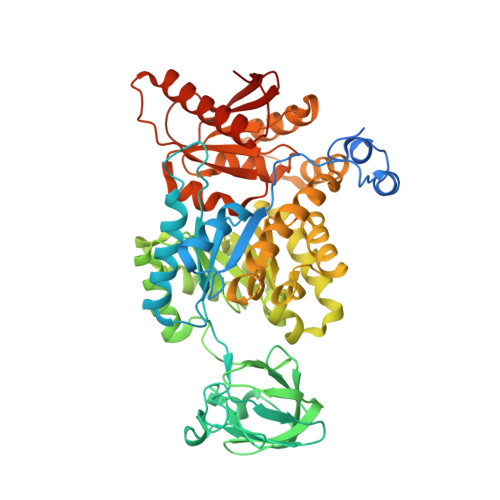Structural basis for tumor pyruvate kinase M2 allosteric regulation and catalysis.
Dombrauckas, J.D., Santarsiero, B.D., Mesecar, A.D.(2005) Biochemistry 44: 9417-9429
- PubMed: 15996096
- DOI: https://doi.org/10.1021/bi0474923
- Primary Citation of Related Structures:
1T5A - PubMed Abstract:
Four isozymes of pyruvate kinase are differentially expressed in human tissue. Human pyruvate kinase isozyme M2 (hPKM2) is expressed in early fetal tissues and is progressively replaced by the other three isozymes, M1, R, and L, immediately after birth. In most cancer cells, hPKM2 is once again expressed to promote tumor cell proliferation. Because of its almost ubiquitous presence in cancer cells, hPKM2 has been designated as tumor specific PK-M2, and its presence in human plasma is currently being used as a molecular marker for the diagnosis of various cancers. The X-ray structure of human hPKM2 complexed with Mg(2+), K(+), the inhibitor oxalate, and the allosteric activator fructose 1,6-bisphosphate (FBP) has been determined to a resolution of 2.82 A. The active site of hPKM2 is in a partially closed conformation most likely resulting from a ligand-induced domain closure promoted by the binding of FBP. In all four subunits of the enzyme tetramer, a conserved water molecule is observed on the 2-si face of the prospective enolate and supports the hypothesis that a proton-relay system is acting as the proton donor of the reaction (1). Significant structural differences among the human M2, rabbit muscle M1, and the human R isozymes are observed, especially in the orientation of the FBP-activating loop, which is in a closed conformation when FBP is bound. The structural differences observed between the PK isozymes could potentially be exploited as unique structural templates for the design of allosteric drugs against the disease states associated with the various PK isozymes, especially cancer and nonspherocytic hemolytic anemia.
- Center for Pharmaceutical Biotechnology and Department of Medicinal Chemistry and Pharmacognosy, University of Illinois at Chicago, Chicago, Illinois 60607, USA.
Organizational Affiliation:






















